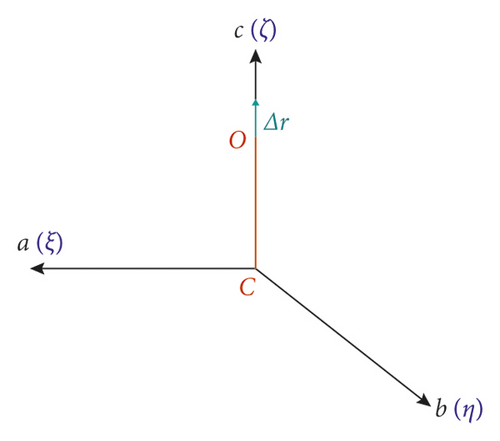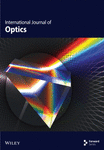A Simplified Method of Microscopic Polarizability Tensor Differential of Hyper-Raman Spectroscopy Based on the Bond Additivity Model
Abstract
Coherent anti-Stokes Raman spectroscopy (CARS) and Ccherent anti-Stokes hyper-Raman spectroscopy (CAHRS), as other high-order nonlinear spectroscopy techniques, are widely exploited in many research fields, such as dynamic processes, gene expression spectrum screening, high-resolution spectroscopy, and nonlinear high-resolution imaging. However, it is difficult to make a quantitative analysis of the spectral signals that involve a large number of high-order micropolarizability tensors. It is reported that the CARS and CAHRS microscopic hyperpolarizability tensor elements can be decomposed into the product of the differentiation of Raman microscopic polarizability tensor α′i′j′ and hyper-Raman microscopic polarizability tensor β′i′j′k′ so that the high-order spectra can be simplified to the analysis of low-order spectra. In this paper, we use the bond additivity model (BAM) combined with experimental corrections to address the carbon dioxide (CO2) molecule and present the simplified scheme for differentiation of hyper-Raman microscopic polarizability tensor elements β′i′j′k′. Taking advantage of this approach, combined with the experimental correction, the differentiation of Hyper-Raman microscopic polarizability tensor elements β′i′j′k′ of the CO2 is obtained and the expressions of β′i′j′k′ for antisymmetric vibrations of CO2 are deduced. Finally, substituting the differentiation of Raman microscopic polarizability tensor elements α′i′j′ reported in the literature into the ratio above can obtain the proportional relationship between the microscopic polarizability tensor elements of CARS and CAHRS of the CO2. This method can provide the basis for the quantitative analysis of high-order nonlinear spectral profiles.
1. Introduction
In the past ten years, as a high-order nonlinear spectroscopy technique, coherent anti-Stokes Raman spectroscopy (CARS) and its surface enhancement methods [1–6] and coherent anti-Stokes hyper-Raman spectroscopy (CAHRS) [7–9] have gained important applications in kinetic processes, gene expression profile screening, high-resolution spectroscopy, nonlinear high-resolution imaging technology, and so on. However, the abovementioned research only carried out qualitative analysis of spectral signals and lacked quantitative analysis of spectral signals. This limits its application to some extent. As a high-order nonlinear coherent optical process, the spectral signals of CARS and CAHRS are contributed by the third and fourth-order microscopic polarizability tensor elements of molecular groups [10]. For n-order nonlinear coherence spectroscopy, the number of molecular microscopic polarizability tensor elements is 3n+1. For example, CARS involves 81 molecular microscopic polarizability tensor elements. These large numbers of molecular microscopic polarizability tensor elements will lead to greater difficulties in the quantitative analysis of high-order nonlinear coherent optical processes [10]. In addition, in view of the nonlinearity of CARS and CAHRS, the complexity of such approaches results increased. In order to facilitate the analysis of the results, the most commonly used experimental configuration is the vertical incidence type [2]. However, with the in-depth study of the theory of high-order nonlinear optical processes and the development of high-order nonlinear optical technologies, experimental techniques and experimental methods will gradually be improved. In the case of noncollinear experimental configurations with non-normal incidence, the acquisition of the high-order microscopic polarizability tensor element is particularly important for the quantitative analysis of spectral signals.
When we get the ratio between μ′i′, α′i′j′, and β′i′j′k′, we can obtain the proportional relationship between the microscopic polarizability tensor elements of CARS and CAHRS of CO2 through the expressions (3)–(5).
Bond additivity model (BAM) is usually used to solve the ratio of Raman microscopic polarizability tensor elements differential in literature [11, 15, 16]. Notably, when Wang group [17] discussed the SFG-VS signal at the air/methanol interface, it was found that the ratio between the differential α′i′j′ of the Raman microscopic polarizability tensor derived from the traditional BAM was brought into the SFG-VS quantitative analysis method, and the results were inconsistent with the experimental measurement. Therefore, the results of BAM are corrected by the method of experimental correction, so that the results are in good agreement with the measured interface sum-frequency vibration spectra. In this paper, by using the BAM and its experimental modification, a simplified scheme is proposed to calculate the hyper-Raman microscopic polarizability tensor differential β′i′j′k′ of the carbon dioxide (CO2) molecule. This approach is quite general, and it can be extended to other nonlinear coherent Raman spectroscopic techniques to simplify the relationship between the microscopic polarizability tensor elements and quantitative analysis of the experimental signal, such as time-domain Raman spectroscopy [18, 19], stimulated Raman scattering [20, 21], and nonlinear high-resolution microscopy [5, 6]. In order to carry out this work, the anharmonic mode couplings and higher-order corrections to the molecular polarizabilities have been neglected in this paper.
2. BAM Solves β′i′j′k′ of Single Bond
The BAM method is based on the assumption of the local mode of a molecular group and the assumption of the local mode of a single bond. In this model, the hyper-Raman microscopic polarizability corresponding to the stretching vibration of a single bond in the group is coupled by symmetry analysis, and the expression of the hyper-Raman microscopic polarizability tensor differential corresponding to each normal vibration mode of the molecular group is obtained. In the BAM method, the discussion of a single bond is the basis of the whole molecular group discussion. Therefore, we first discuss the β′i′j′k′ of single bond CO with C∞v symmetry in Figure 1.

3. BAM Solves β′i′j′k′ of CO2
Coupling the β′i′j′k′ of two single bond CO, the expression of β′i′j′k′ of CO2 can be obtained.

From the expressions (50)–(51), the ratios , , , and , are only related to r1 and r2 of single bond CO. And r1 and r2 can be obtained by measuring the hyper-Raman depolarization rate [17].
4. Experimental Correction of r1 and r2
The ratios of r1 and r2 can be obtained by experimentally measuring the hyper-Raman depolarization rate [22]. The experimental optical path for measuring the hyper-Raman depolarization rate is shown in Figure 3. (x,y,z) represents the laboratory coordinate system. The direction of the incident light is parallel (H) to or perpendicular (V) to the horizontal plane (xy plane). The outgoing light is detected in a direction at a 90° angle to the incident light, and the detected polarization direction is the vertical (V) direction. By selecting the polarization of the incident and outgoing light, the signals IHV and IVV of the two polarization combinations can be obtained. The expression of the hyper-Raman depolarization rate of a certain vibrational mode of the studied molecule is shown in expression (52), and (I,J,K = x,y,z) is shown in expression (53) [19].

In which RIi is the matrix element of the Euler transformation from the molecular coordinate system to the laboratory coordinate system, β′ijk is the hyper-Raman microscopic polarizability tensor differentials. The expressions (46)–(49) are introduced into expression (53) to obtain the relationship between the hyper-Raman depolarization rate and the r1, r2, and τ. If for a certain molecular group, can be measured to the symmetric vibration mode of the hyper-Raman depolarization rate ρSS and antisymmetric vibration mode of the hyper-Raman depolarization rate ρAS, we could be using the values of ρSS and ρAS to determine the value of r1 and r2.
The value of r1 and r2 can be solved by taking the experimental measured and into expressions (54) and (55).
Using the experimentally modified BAM method, we can get the ratio of the hyper-Raman microscopic polarizability tensor element differentials that is consistent with the experimental results. Combining the ratio between the Raman microscopic polarizability tensor differentials, and bringing the above relation into the expressions (50) and (51), we can greatly simplify the relationship between CARS and CAHRS microscopic polarizability tensors.
Through the presented analysis, we obtained the ratios between the hyper-Raman microscopic polarizability tensor element differentials β′i′j′k′. Combining the ratios between Raman microscopic polarizability tensor element differentials α′i′j′ in the literature, we obtain the proportional relationship between the microscopic polarizability tensor element of CARS and CAHRS.
5. Conclusions
In this paper, a simplified method of microscopic polarizability tensor differential of hyper-Raman spectroscopy based on BAM is investigated. In the first, we use the differentiation of Raman microscopic polarizability tensor α′i′j′ and the hyper-Raman microscopic polarizability tensor β′i′j′k′ to mean the CARS and CAHRS microscopic hyperpolarizability tensor elements, so the high-order spectra can be simplified to the analysis of low-order spectra. Then, taking the CO2 molecule as an example, we use the bond additivity model method to analyze the normal vibration mode of the single bond stretching vibration to obtain the hyper-Raman microscopic polarizability tensor element differential β′i′j′k′ of the single bond CO. On that basis, by analyzing the symmetry of the CO2 molecule, the β′i′j′k′ of the two single bonds are vector-coupled to obtain the expressions of the hyper-Raman microscopic polarizability tensor element differential β′i′j′k′ of the two normal vibration modes of the CO2 molecule. Finally, combining the ratios between Raman microscopic polarizability tensor element differentials α′i’j, we derived the relationship between the microscopic polarizability tensor element of CARS and CAHRS. The above analysis provides a theoretical basis for the quantitative analysis of high-order nonlinear spectral signals in symmetric molecular systems with 2 or 3 atoms.
This approach is quite general, and it can be extended to other nonlinear coherent Raman spectroscopic techniques to simplify the relationship between the microscopic polarizability tensor elements and quantitative analysis of the experimental signal, such as time-domain Raman spectroscopy, stimulated Raman scattering, and nonlinear high-resolution microscopy.
Conflicts of Interest
The authors declare that they have no conflicts of interest.
Open Research
Data Availability
No data were used to support this study.




